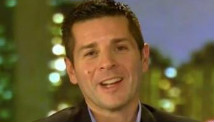STORY HIGHLIGHTS
- The measure now goes to the House where a vote could come Tuesday
- A statement from House leadership made no promises
- Under the Senate package, taxes would stay the same for most Americans
- It leaves a range of big issues unaddressed.
As the fiscal cliff looms, what's your New Year's message to Washington? Go to CNN iReport to share your video.
(CNN) -- A full two hours after a midnight deadline, the Senate overwhelmingly passed a deal Tuesday to avert the feared fiscal cliff on an 89-8 vote.
The Senate package would put off budget cuts for two months and preserve Bush-era income tax cuts for individuals earning less than $400,000 or couples earning less than $450,000.
The measure now goes to the House where it faces an uncertain future in the Republican-controlled body.
"Glad it's over," said Senate Majority Leader Harry Reid, D-Nevada, after the vote. "We'll see if the Republicans in the House can become functional instead of dysfunctional."
A statement from House leadership made no promises.
"Decisions about whether the House will seek to accept or promptly amend the measure will not be made until House members -- and the American people -- have been able to review the legislation," the statement said.
A vote could come as early as New Year's Day. The House is scheduled to convene at noon.
Sen. John Hoeven, R-North Dakota, was hopeful the House will follow suit.
"The vote was 89 to 8. Bipartisan vote. 89 votes," he said. "I think it sends a strong message and I think it will be approved by the House."
What the package proposes
Read the bill (pdf)
Under the Senate package:
-- Taxes would stay the same for most Americans. But it will rise for individuals making more than $400,000 and couples making more than $450,000. For them, it will go from the current 35% to the Clinton-era rate of 39.6%.
-- Itemized deductions would be capped for those making $250,000 and for married couples making $300,000.
-- Taxes on inherited estates will go up to 40% from 35%.
-- Unemployment insurance would be extended for a year for 2 million people.
-- The alternative minimum tax -- a perennial issue -- would be permanently adjusted for inflation.
-- Child care, tuition and research and development tax credits would be renewed.
-- The "Doc Fix" -- reimbursements for doctors who take Medicare patients -- will continue, but it won't be paid for out of the Obama administration's signature health care law.
-- Prevents a spike in milk prices. Agriculture Secretary Tom Vilsack said milk prices would have doubled to $7 a gallon because a separate agriculture bill had expired.
What's not addressed
While the package provides some short-term certainty, it leaves a range of big issues unaddressed.
It doesn't mention the debt ceiling, and temporarily puts off for two months the so-called sequester -- a series of automatic cuts in federal spending that would have taken effect Wednesday. It would have reduced the budgets of most agencies and programs by 8% to 10%.
This means that, come late February, Congress will have to tackle both those thorny issues.
"We're going to have to deal with the sequester, that's true," said Sen. Max Baucus, D-Montana, "but look, this is better than nothing."
Reid said the agreement was a win for average Americans.
"I've said all along that our most important priority was to protect the middle class families," he said. "This legislation does that."
And maybe a bit more.
According to the U.S. Census Bureau, median household income in 2011 was $50,054, which is well below the tax cut threshold approved by the Senate.
Senate Minority Leader Mitch McConnell, R-Kentucky, praised the effort, but said it shouldn't have taken so long to get an agreement.
"We don't think taxes should be going up on anyone but we all knew that if we did nothing they would be going up on everyone today," he said. "We weren't going to let that happen."
All eyes on the House
As lawmakers left the chamber around 2 a.m., there was no sentiment of celebration, more a sense of relief that the vote was done.
One of the last members to leave was 88-year-old retiring Hawaii Senator Daniel Akaka. He walked down the steps bent over his cane, assisted by an aide, but smiling.
Others rubbed their eyes from lack of sleep. It was the end to a very long, down-to-the wire day -- and all eyes now turn to the House.
There's a lot at stake.
If the House doesn't act and the Bush administration's 2001 and 2003 tax cuts expire, broad tax increases will kick in as will $110 billion in automatic cuts to domestic and military spending.
The nonpartisan Congressional Budget Office has predicted the combined effect could dampen economic growth by 0.5%, possibly tipping the U.S. economy back into a recession and driving unemployment from its current 7.7% back over 9%.
President Barack Obama urged House members to pass the package "without delay."
GOP sources said House members saw little practical difference in settling the issue Monday night versus Tuesday.
But if tax-averse House Republicans approve the bill on Tuesday -- when taxes have technically gone up -- they can argue they've voted for a tax cut to bring rates back down, even after just a few hours, GOP sources said. That could bring some more Republicans on board, one source said.
Read more: Why your paycheck is getting smaller, no matter what
Concerns persist
Read more: What if there's no deal on fiscal cliff
The White House budget office noted in September that sequestration was designed during the 2011 standoff over raising the federal debt ceiling as "a mechanism to force Congress to act on further deficit reduction" -- a kind of doomsday device that was never meant to be triggered. But Congress failed to substitute other cuts by the end of 2012, forcing the government to wield what the budget office called "a blunt and indiscriminate instrument."
In its place, the Senate plan would use $12 billion in new tax revenue to replace half the expected deficit reduction from the sequester and leave another $12 billion in spending cuts, split half-and-half between defense and domestic programs.
Despite the progress, the White House cautioned that deficit reduction still requires more work.
"But tonight's agreement ensures that, going forward, we will continue to reduce the deficit through a combination of new spending cuts and new revenues from the wealthiest Americans," Obama said.
Read more: Medicare patients may suffer if country goes over fiscal cliff
Conservative lobbyist Grover Norquist, whose Americans for Tax Reform pushes candidates to sign a pledge never to raise taxes, said the plan "right now, as explained" would preserve most of the Bush tax cuts and wouldn't violate his group's pledge.
"Take the 84% of your winnings off the table," Norquist told CNN. "We spent 12 years getting the Democrats to cede those tax cuts to the American people. Take them off the table. Then we go back and argue about making the tax cuts permanent for everyone."
But Robert Reich, who served as labor secretary in the Clinton administration, said the $450,000 threshold "means the lion's share of the burden of deficit reduction falls on the middle class, either in terms of higher taxes down the road or fewer government services." In addition, he said, the plan does nothing to raise the federal debt ceiling just as the federal government bumps up against its borrowing limit.
And that, Arizona GOP Sen. John McCain told CNN, is likely to be "a whole new field of battle."
"We just added 2.1 trillion in the last increase in the debt ceiling, and spending continues to go up," McCain said. "I think there's going to be a pretty big showdown the next time around when we go to the debt limit."
CNN's Matt Smith, Mike Pearson, Jessica Yellin, Dana Bash, Deirdre Walsh, Lisa Desjardins, Ted Barrett and Ashley Killough contributed to this report.













